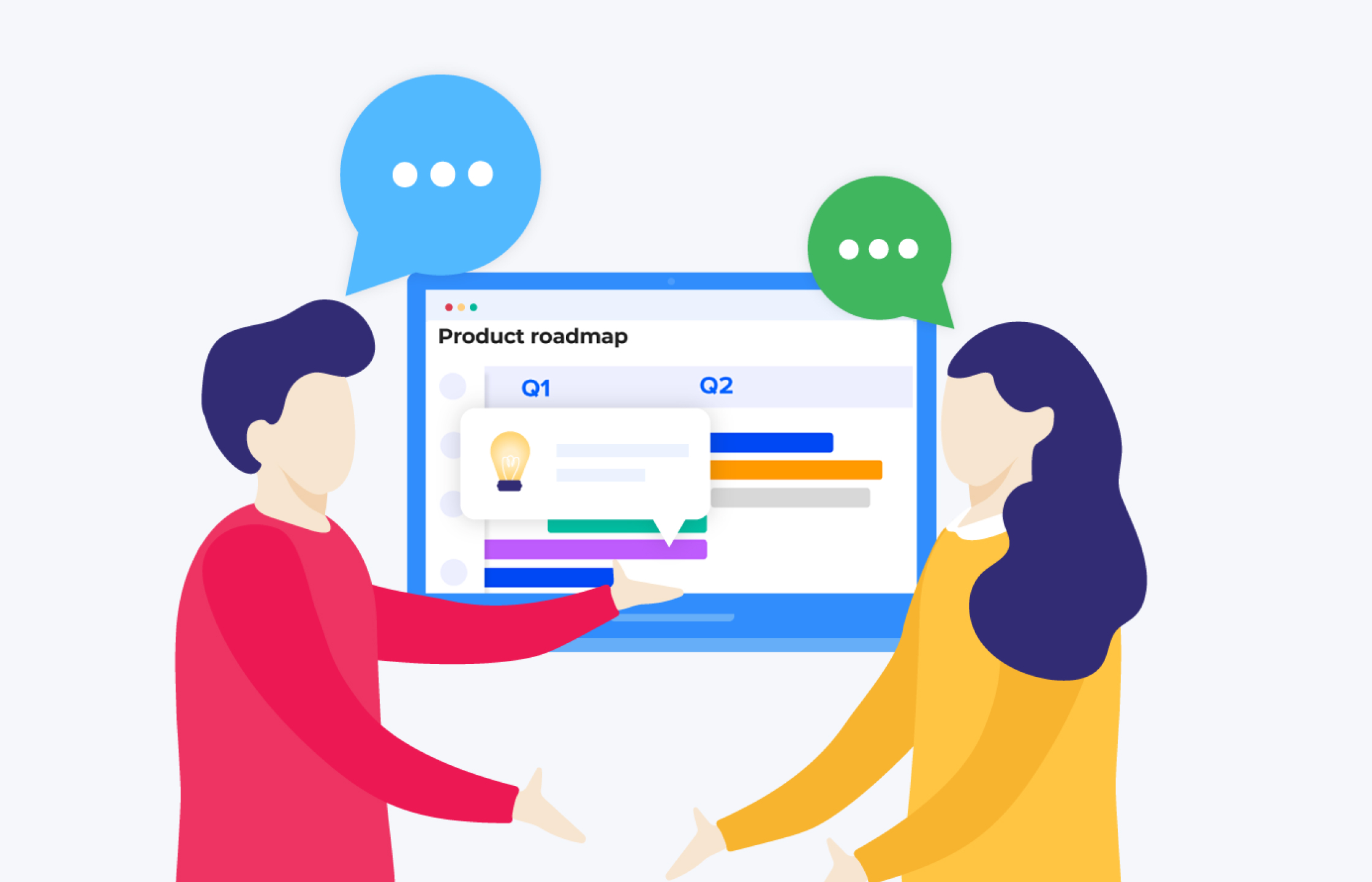We all want customers to adopt as much as possible from the product. But how can we actually include the voice of the customer in the product roadmap, to make that happen? And what are the responsibilities of Product versus Customer Success?
In this blog we dive into what we see as the current problems that arise when dealing with customer feedback, and make a case for a new and better way: a data driven approach that leads to success for all stakeholders.
For most of our customers—like Mixpanel and Personio—a project to launch a Customer Community is led by the Customer Success or Customer Experience department. But for a smaller group—like Gainsight—it’s the Product department who is taking the lead. Over time I have grown to understand why: Both departments share a common goal. They both want to make sure customers get the maximum value from their product and achieve the business outcomes they set out to achieve.
Let’s take one step back. We can all understand that a customer that doesn’t achieve any value from your product, is not going to renew. Maybe you can get away with it for a short period of time, especially if you’ve built a great customer relationship.
At inSided, we have definitely been there as well in the early days. Customers renewed because of us, not necessarily due to the value of our product. But this is not sustainable in the long-term and it’s not a growth strategy, so we had to make quite some changes to our approach. Improving the value customers achieve from your product, and the overall improvement of the product itself, should be a continuous top-priority. In order to do this well, you need to get the Voice of the Customer into your roadmap, by fueling your core product management process with their feedback.
The problem with Customer Success Managers & product feedback
As a Customer Success Manager, you are in continuous contact with your most important customers. While speaking to them, in most cases you will also get a lot of feedback on your product. But how should you structure circling that back to the Product department, when you also need to focus on working on success plans, proactively reaching out to customers at risk, answer all incoming questions you get on a daily basis, etc. Most Customer Success Managers I know already have quite a long to-do list, so providing structured feedback to the Product team is probably not their first priority.
And what about the long-tail of customers that you don’t even speak to 1–1 on a regular basis as a Customer Success Manager? Those tens, hundreds and sometimes even thousands of customers, who don’t have a dedicated CSM—what about their feedback? How does a Customer Success department make that feedback visible to the Product team?
Of course you could say, it’s the responsibility of the Product department. They are responsible for the product. But we live in a world where Customer Success teams are also responsible for customers deriving value from your product. So getting customer feedback in the roadmap process is imperative. And everyone will be looking to Customer Success to bring insights from customers and bridge that gap.
The problem with Product Managers and product feedback
With the product being your raison d’être, you clearly want to build the best product out there. You make use of multiple sources of information from churn reports to sales feedback to the competitive landscape. However, you can easily be overwhelmed by all the different directions you get pulled into. Also managing, tagging and classifying all input can be a labor intensive job. Defaulting to current customer feedback is usually a good strategy. These are the customers you definitely want to keep. Luckily most Product teams understand that they need to include customer feedback in their roadmap to build what customers actually want and need. But how can the team possibly know about all the needs and wishes out there? And how can you effectively prioritize all that feedback? As we all know, we shouldn’t build every individual feature request.
Also, Product teams have finite resources and time available. Speaking to all customers 1:1 on a regular basis is just not possible. And with an increasing customer base, it becomes even more difficult to have the breadth and depth of intimately understanding the customers. Product teams are in desperate need of getting customer insights, but often struggle with a lack of data points, incomplete information and not enough time. Apart from that, they lack overall insights across the entire customer base, not to mention insights split by different customer segments, geography or SME versus Enterprise customers.
All in all, Product and Customer Success teams need each other. Creating a strong partnership with a seamless flow of insights, leads to higher product adoption and customer renewals. So let’s explore how organisations can set this up.
Creating a seamless direct flow of customer feedback
Traditionally, feedback from customers flows through CSM, Support teams or even Account Managers. There’s no doubt this results in an incomplete stream of information. We know when a new customer signs up, we need to make sure the Sales-CS handover is optimized. But what about the CS-Product feedback handover?

In the new way, customers are in seamless contact with the Product Department, the Customer Success Team AND other customers who might have the same wishes. There is a value exchange between all stakeholders.

In this new way, product feedback doesn’t flow through one to one interactions to be easily forgotten or put on the shelf. There is a transparent flow of information among all stakeholders. The new way also includes a flow of information between customers. This enables customers to see each other’s feedback, jointly engage on this and offer other customers workarounds on potential requests they have. Ultimately, this holistic approach provides you with a much more complete picture of customer feedback. If customers collaborate on their requests, you will get improved insights into prioritization from your entire customer base.
Use technology & processes to support the feedback loop
In order to make this transparent flow happen, technology and processes need to be put in place. From a technology perspective, these are some of the required capabilities to make this flow efficient and effective:
- A Single Platform: You need one platform where all stakeholders can participate (open or closed for customers only)
- Ensure Transparency: Customers need to be able to submit their ideas, see the status of their ideas and get transparent feedback from the company.
- Encourage Engagement: Other customers need to be able to see a list of ideas, engage in discussions around those ideas, upvote ideas which they also think are a priority. This will result in a prioritized list of feature requests from your entire customer base.
- Effective Analytics: The Product team needs to be able to see all individual ideas and provide feedback on them, have the ability to change the status of individual ideas (eg ‘added to backlog’, ‘will not implement’ or ‘delivered’), but also see aggregated statistics of those ideas to make strategic roadmap decisions.
- Clear Navigation: The Customer Success team needs to be able to direct customers to the platform as the main venue for submitting product ideas to start with.
- Stats and Integrations: Both Customer Success and Product teams need to see the aggregated statistics to have a meaningful conversation. For this, connecting customer feedback to tools like Gainsight and Salesforce is crucial. Customer driven business cases can be created if the top ideas for all customers combined are clear. Or which ideas represent how much aggregated ARR value, which ideas come from Enterprise versus SME customers, or which come from customers who will renew in the upcoming period.
Of course this technology needs to be backed with some rudimentary processes. When does the product team come together to discuss all (new) ideas submitted by customers? When does the team provide closed loop feedback to customers? Which of course also means being transparent on the requests which are not part of your strategy or short/long term roadmap. That’s totally fine—customers understand (and expect & appreciate!) that not all their wishes can be translated into product updates.
Also within Customer Success, Support or Account Management, the process of handling feature requests needs to be adjusted to incorporate a centralized platform. A discussion of individual feature requests preferably does not happen in EBRs or within support requests anymore. And internally there needs to be an open discussion between the teams on what to do with the feedback your customers give you. Managing mutual expectations is crucial here, in order to have a healthy relationship between the teams.
But in this centralized environment, true Customer Success happens for all. A truly data-driven conversation can happen between the Customer Success organisation and the Product organisation. And this is important because they both share the same goal—making sure customers get value from the product—ultimately renew and remain your customer.


